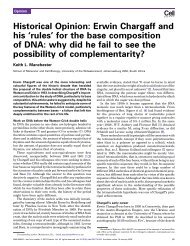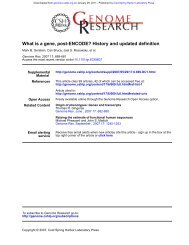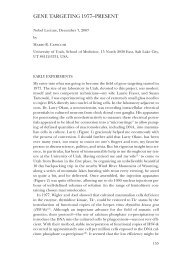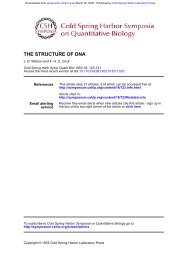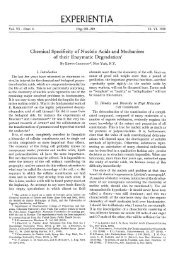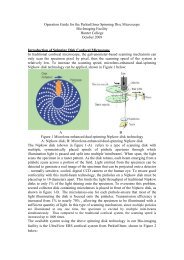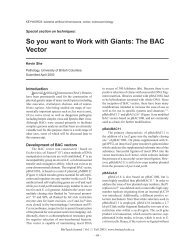Chargaffs Legacy.pdf - Biology
Chargaffs Legacy.pdf - Biology
Chargaffs Legacy.pdf - Biology
- No tags were found...
Create successful ePaper yourself
Turn your PDF publications into a flip-book with our unique Google optimized e-Paper software.
130D.R. Forsdyke, J.R. Mortimer / Gene 261 (2000) 127±137survival the `®ttest' viruses whose genes encoded optimalproteins. However, it was observed that the base sequenceseems to serve the needs of nucleic acid structure just asmuch as the protein-encoding function. Indeed, the needsof nucleic acid structure are sometimes served better thanthose of the protein-encoding function. Since bacteriophagesdo not encode rRNAs and tRNAs, the possibility arose that itwas the structure of mRNAs which was of selective importance.Winston Salser noted (Salser, 1970):ªRNA phage R17 has very extensive regions of highlyordered base pairing. It has seemed likely that thismight be necessary to allow phage packaging. BerniceRicard and I were therefore somewhat surprised to®nd that T4 messengers [mRNAs], which do nothave to be packaged, also have a very large amountof secondary structure. ¼Our results suggest that ahigh degree of secondary structure may be importantin the functioning of most mRNA molecules. Becauseof the very high Tm's [temperature at which theªmeltingº of secondary structure is half maximum]we do not think that the base pairing seen is random.The possible functions of such extensive regions ofbase-pairing are unknown.ºIn 1972 Andrew Ball (Ball, 1972, 1973a,b) went furthernoting that:ªThe selection pressure for speci®c base pairing in amessenger RNA severely limits its coding potentialº,¼ so that ¼ ªthere is a pressure for some amino acidsequences to be selected according to criteria whichare distinct from the structure and function of theprotein they constitute.ºThis conclusion was supported by better algorithms forcalculating RNA secondary structure (Jaeger et al., 1990),which showed that for many mRNA sequences the energeticsof the folding of the natural sequence are betterthan those of the corresponding shuf¯ed sequence (i.e. onewould have to shuf¯e and fold many times to arrive bychance at a structure approaching the stability of the naturalsequence; Le and Maizel, 1989; Forsdyke, 1995a; Seffensand Digby, 1999). It appeared that `the hand of evolution'had arranged the order of bases to support mRNA structure,sometimes at the expense of the coding function.Although abundantly present in the cytoplasm, tRNAsand rRNAs are encoded by a relatively small part of microbialgenomes. In microorganisms the sequence of mRNAs,as an RNA entity, are more representative of the genome. Ifmany mRNAs have highly signi®cant secondary structure,then the corresponding genomic regions should also havethis potential. Indeed, the primary evolutionary pressure forthe elaboration of mRNA secondary structure might havebeen at the genomic level rather that at the mRNA level. Ifso, regions of a genome which are not transcribed intomRNAs might also demonstrate potential for secondarystructure. When folding algorithms were applied to thesequences of individual DNA strands, it was found thatthere is indeed considerable potential for secondary structure.Stem-loop potential in DNA is not restricted to regionsencoding mRNA (or rRNA or tRNA), but is also present inintrons and in intergenic DNA. Stem-loop potential, greaterthan that of the corresponding shuf¯ed sequence, is diffuselydistributed throughout the genomes of all species examined(Forsdyke, 1995a,b,c; Heximer et al., 1996).The con¯ict with the protein-encoding function wasfound to be particularly apparent in the case of genes evolvingrapidly under positive Darwinian selection (Forsdyke,1995b, 1996a). In these cases the pressure to adapt theprotein sequence has been so powerful that base order hasnot been able to support stem-loop potential. The naturalprotein-encoding sequence has less stem-loop potential thanthe corresponding shuf¯ed sequence. Stem-loop potential isthen diverted to introns, which are more conserved than thesurrounding exons. Intron stem-loop potential is greaterthan in the corresponding shuf¯ed sequence. This supportsan explanation for the early origin of introns, which postulatesthat protein-encoding potential was imposed on prototypicgenomes already supporting stem-loop potential(Forsdyke, 1995a,b,c).At least by virtue of the stems in DNA stem-loop structures,it follows that there would have been an evolutionarypressure for single-strands of DNA to have approximateequivalences of the Watson-Crick pairing bases. Thus,Chargaff's second parity rule is consistent with singlestrands of DNA having considerable potential for formingsecondary structure. The possible adaptive value of thissecondary structure at the genomic level will be discussedafter ®rst considering the adaptive value of purine-loading atthe post-transcriptional level.4. Adaptive value of purine loadingAn important implication of what is now called `Szybalski'stranscription direction rule' is that RNAs, in general,tend to be purine-loaded (Figs. 1 and 2). This observation issuggested by Chargaff's early work on the base compositionof total RNA from various species, but his data would thenhave mainly re¯ected the compositions of the most abundantRNA form, the ribosomal RNAs (rRNAs; Chargaff,1951; Elson and Chargaff, 1955). When purine-loadingwas found to apply to RNAs in general, the possibilityarose that the selection pressure for this might have arisen,not at the transcription level, but post-transcriptionally at thelevel of individual RNA molecules. Given that mRNAs tend(i) to be loaded with runs of purines (the cluster rule) and (ii)to have an elaborate secondary structure (consistent withChargaff's second parity rule), where in the structureswould purine clusters be found?Since for base-pairing purine clusters must be matched



